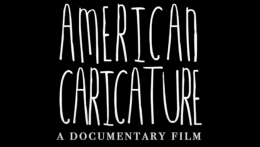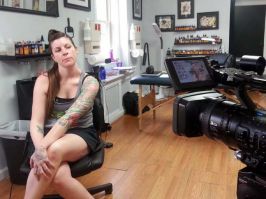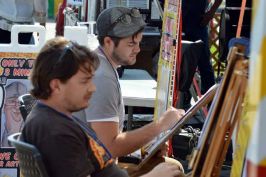American Caricature Interview
 | |
| Author | Manny Avetisyan |
|---|---|
| Subject | American Caricature, Tom Faraci |
| Genre | Interview |
| Published | EF Issue 2019.3 |
Publication date | Summer 2019 |
| Media type | Digital |
| Pages | 18-21 |
| Website | caricature |


Contents
Article Transcript
ISCA Vice President Tom Faraci answers some questions about his upcoming documentary American Caricature, which chronicles the 2015 ISCA Caricature Convention, the year leading up to it, and features interviews with many of our esteemed members. They’re crowdfunding on Kickstarter until 2pm EST, Thursday Aug 29!
Manny: Is Tom Faraci your real name or is it your Caricature alias?
Tom: You got me. My real name is Thomas.
Manny: Where and when did your love for caricature begin? That’s a hard answer to pin down. I think I first grasped the concept when I was 9 or 10 and I was first exposed to Mad Magazine. I remember my mom being appalled that I was reading such filth, but it wasn’t long before my dad was introducing me to his Mad collection from the ’60s,’70s, and ’80s. Shortly after, I discovered Mort Drucker’s How to Draw 50 Famous Caricatures in the school library. After I burned through every page of that book, I moved on to trying to draw my family members. So that was probably my earliest introduction to caricature art — but it wasn’t the only influence.
As a kid, my family would take a trip to Cedar Point once a year or so, and I was always fascinated by the caricature artists live sketching guests. I would stop and watch whenever I could. To my eyes, it was magic. Finally, when I was 14, my dad paid to have my caricature drawn (by Brad Rosier, I would learn years later). I remember staring at that drawing in awe the entire weekend, determined to figure out the secrets it held. Why is it I can recognize myself in this drawing? How is it that he was able to capture my likeness in a few simple strokes? I honestly didn’t think my face had any distinction from the next, but somehow he captured it in all of its unique glory. I think it was that moment, and that drawing, that really unlocked the desire in me to pursue live caricature art. I never approached it as a possible profession. I figured one summer and that would scratch the itch, and then I’d move on with my life, a newly minted caricature master. I was so naive — I even remember buying Joe Bluhm’s book, Rejects, thinking “Oh cool, this is the kind of stuff I’ll be doing!” Ha. It’s been 10 years now and I still can’t even come close to what Joe was doing then, but needless to say, those early years were a huge wake-up call and learning experience.
Manny: Tell me about your co-producer Joe Ciomek.
Tom:Simply put, Joe has been my BFF since the third grade. And now that I think about it — that was the same time I first discovered Mad Magazine, so we may have boarded that train together. We met in school, and we only lived a block away from each other. We would often have sleepovers at his house and indulge in all the TV, movies, and video games that my parents would never have let me watch at my house. Though technically, they never specifically told me not to watch Tales From the Crypt, MadTV, or The Exorcist.
Tom: As we got older, we bonded over creative projects. We’d spend days, weeks, months coming up with our own action figure characters. Todd McFarlane’s Spawn was a huge influence there. In high school, Joe was president of the Film Club and I would help him on various film projects while I pursued painting, drawing, and printmaking. That trend carried on through college — while I was studying graphic design and Joe was getting his degree in film, we would collaborate on the occasional short film — including music videos for the band we formed together. So there has always been a throughline of creative team-ups over the years. American Caricature has always felt like a natural progression of that connection.
Manny: What is AMERICAN CARICATURE?
Tom: American Caricature is a documentary film about our community of caricature artists, and it’s been my passion project for the last few years. What started out as an idea to film the convention in 2015 grew into a much more ambitious project. So it’s a look at caricature art as a subculture — a trip down the rabbit hole for the uninitiated. I think a general audience is familiar with artists at theme parks, fairs, gigs, and tourist locations. Even if they don’t recognize the title of “quick sketch” artist or even “live caricature artist,” they’ll have had some interaction, even just in passing, with those of us who do it for a living. Likewise, anyone who has ever picked up a magazine or newspaper in their life has seen editorial or satirical caricature art. American Caricature introduces those familiar styles of caricature art early on, branches off from there to show other professional fields, and then brings it all back around when we show all of those artists competing against one another at the ISCA Con.
Manny: What gave you the idea to make a documentary about Live Caricature in America?
Tom: Well, it’s funny to me, because, as I mentioned, the original plan was to film the convention in Sandusky, Ohio. That was it. The decision to have a focus on live caricature was a way to solve one logistical problem, as was the decision to keep the focus on America. Here was the thought process in a nutshell: Joe was living in Cleveland and I was living in Sandusky. At the end of the 2014 convention in Reno, it was announced that the convention would be returning to Sandusky in 2015. Joe was looking for a new project and had been to at least one convention before. So I called him up right as it was announced and said “Hey man, the con is gonna be in Sandusky next year. Get your camera ready and we’ll document the whole thing.” We really wanted to capture the competition and camaraderie that exists in the caricature community.
Once we were able to have a few real conversations about the direction of the film, we realized we had a full year to get through until the convention. I had just wrapped up my first full year drawing caricatures at festivals with Rob Hren, and Joe wanted to see what that was all about as well. So we decided Joe would follow us on our route and document our year leading up to the con. So that’s where the live caricature angle took form. As for caricature in America, that was our way of setting the scope. After broadening our vision to go beyond just the con, we had to rein it back in a little. In my opinion, you can’t do a movie about a subject as broad as just “caricature” without mentioning Sebastian Krüger, Jan Op De Beeck, Kage Nakanishi — those who are representing the best of caricature art all over the world. And those are just artists working today! I hardly consider myself scholarly enough to try to explore the vast history of caricature artists who are either no longer active or with us. So once we understood those boundaries, it made sense for us to keep the focus of the movie (a) contemporary and (b) limited to locations to which we could reasonably travel — preferably if they were already along our festival route.
It’s also not strictly about live caricature. But to that element, much of this movie is through a personal lens — and being that I’m a live caricature artist and most of my network of peers consists of live caricature artists, it does have a skew toward that side of the profession. But we also have extended segments with Joe Bluhm on his career in animation, Tom Richmond’s work with Mad Magazine, and we catch Jason Seiler in the middle of making revisions for an art director. We really wanted to show the differences and similarities between different professional applications of caricature.
Manny: Besides being a cool film to have made, what do you hope American Caricature will accomplish?
Tom: I hope it shines a light on this industry in a way that hasn’t been done before. I want it to appeal to the average person browsing Netflix or whatever — that they can be compelled to watch and learn what it’s like to do caricatures for a living. When I started interviewing artists, I approached them with a lot of the questions customers ask us all the time — “What’s your real job?” “Did you go to school for this or are you just naturally good at it?” The answer to both of those questions, as we all know, is that it is a job and it’s a lot of work to be able to do this well and live off of it. So I want people to start to understand not only that we take it seriously as a profession, but also that the extent to which we’re passionate about it culminates in this weeklong international draw-off that will leave their minds blown.
But mostly, I hope it makes us filthy stinkin’ rich.
Manny: Has making the documentary changed your perspective on live caricature?
Tom: I don’t know that it has, to be honest. For me, live caricature has been my life for 10 years — and in just the time I’ve spent working on this movie, that landscape has changed so drastically. I’ve seen so many budding artists find their voice and embark on their own caricature journeys — but I’ve been viewing that evolution in real time. And I wish I would have known where they were headed when I started this film, because there are probably like 50 artists on my radar I wish I could have included more comprehensively — and that includes you, Manny!
My only concern now is that when the movie is released, it will already feel dated because of how fast the art form continues to evolve in a live setting. I guess if there’s one takeaway I learned from it, after talking to various studio artists, it’s that live caricature isn’t the “easy” caricature career I viewed it as. Or at least that I thought others viewed it as. I guess it’s been validating, in a way, to know that what we do as live artists can’t be re-created in a studio, and the skill sets required to be successful at either are vastly different.
Manny: Are you excited to screen your film at ISCA?
Tom: Hell yes! We have a full movie theater in Memphis! How perfect is that? Knowing that ahead of time really was the push we needed to finally get this thing finished. Besides that, what better audience to have the first viewing than the group of folks who inspired the film? Yeah, I’m super excited to show it at ISCA and to take in everyone’s reaction live and in person.
Manny: Do you have broader plans for getting the film out to the public?
Tom: We do have some short-term plans. So our goal for 2020 is to show it in as many film festivals as we can get into, starting with The Cleveland International Film Festival. (Shameless plug incoming) We’re also currently funding on Kickstarter. Right now, as long as it’s successful, backing it there is the only way we can guarantee a copy of the film to own. That’s running until August 29, 2019. So apart from backing us on Kickstarter and catching it at a festival next year, we hope to arrange for some kind of streaming distribution. But we won’t know what that is until after the festival run ends. One step at a time!
Manny: What’s next for the filmmaking duo Lucky Card Productions?
Tom: Well, we’ve been working on a sort of follow-up to American Caricature in secret. It’s a short film, this time a documentary that catches up with our friend Glenn Ferguson. For those who don’t know, Glenn Ferguson — former ISCA board member, Golden Nosey Winner, Master Caricaturist, and now ISCA Hall of Famer — nearly lost his life in an attack on New Year’s Day 2016. This was a month and a half after we had wrapped filming. … I don’t really want to recount the grisly details here, but just understand that at the time, we weren’t sure if Glenn was going to wake up, let alone return to his normal life. We were just sitting down to start editing our film, and here we had this two-hour-long interview with Glenn from literally just a year prior. We cut some of that together to raise awareness for Glenn’s GoFundMe campaign before we even touched any other footage.
We had a lot of ethical concerns about, well, what do we do now? Do we address this awful thing that happened or just stay on track and focus on the year before Glenn was stabbed? So Joe and I pumped the brakes for long enough to discuss our options. And we decided it would be best to follow up on the events as they unfold, even though we were in entirely uncharted territory. Suddenly, there was a dark cloud over this otherwise fun and whimsical film about the caricature community. So after a few months had passed, I spoke with Glenn and JoAnn to see how they’d like us to proceed. They agreed to an interview about the attack, and, well, we just went from there. We decided in the end that this was its own story, and we would tell it as such. So that film is called Glenn Ferguson: After the Storm. It’s also available via our Kickstarter campaign, and the hope is to release both movies simultaneously.
Beyond that, Joe and I have some ideas. I think we both want to try fiction — something scripted as opposed to a documentary. But we’re a ways off from tackling something new — gotta finish American Caricature first!
ISCA Exclusive Extended Look
See Also
External Links
This Navigation box may not show up on mobile browsers. Please see Exaggerated Features Issue 2019.3 for the full contents of this issue if the navigation box does not display.
